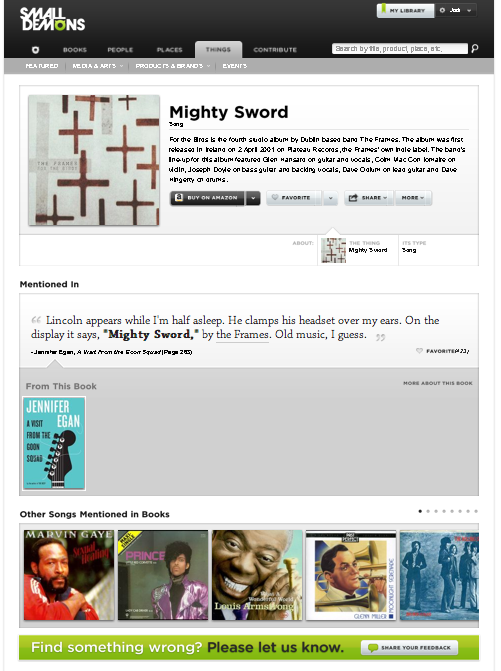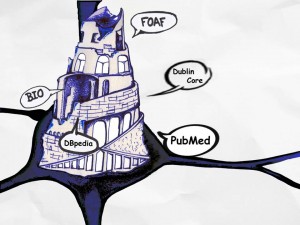I am not aware of a consensus definition of knowledge graph. I’ve been discussing this for awhile with Liliana Giusti Serra, and the topic came up again with my fellow organizers of the knowledge graph session at US2TS as we prepare for a panel.
I’ve proposed the following main features:
- RDF-compatible, has a defined schema (usually an OWL ontology)
- items are linked internally
- may be a private enterprise dataset (e.g. not necessarily openly available for external linking) or publicly available
- covers one or more domains
Below are some quotes.
I’d be curious to hear of other definitions, especially if you think there’s a consensus definition I’m just not aware of.
“A knowledge graph consists of a set of interconnected typed entities and their attributes.”
“A knowledge graph is a structured dataset that is compatible with the RDF data model and has an (OWL) ontology as its schema. A knowledge graph is not necessarily linked to external knowledge graphs; however, entities in the knowledge graph usually have type information, defined in its ontology, which is useful for providing contextual information about such entities. Knowledge graphs are expected to be reliable, of high quality, of high accessibility and providing end user oriented information services.”
Boris Villazon-Terrazas, Nuria Garcia-Santa, Yuan Ren, Alessandro Faraotti, Honghan Wu, Yuting Zhao, Guido Vetere and Jeff Z. Pan . “Knowledge graphs: Foundations”. In Exploiting Linked Data and Knowledge Graphs in Large Organisations. Springer. Part of the whole book: http://link.springer.com/10.1007/978-3-319-45654-6
“The term Knowledge Graph was coined by Google in 2012, referring to their use of semantic knowledge in Web Search (“Things, not strings”), and is recently also used to refer to Semantic Web knowledge bases such as DBpedia or YAGO. From a broader perspective, any graph-based representation of some knowledge could be considered a knowledge graph (this would include any kind of RDF dataset, as well as description logic ontologies). However, there is no common definition about what a knowledge graph is and what it is not. Instead of attempting a formal definition of what a knowledge graph is, we restrict ourselves to a minimum set of characteristics of knowledge graphs, which we use to tell knowledge graphs from other collections of knowledge which we would not consider as knowledge graphs. A knowledge graph
-
mainly describes real world entities and their interrelations, organized in a graph.
-
defines possible classes and relations of entities in a schema.
-
allows for potentially interrelating arbitrary entities with each other.
-
covers various topical domains.”
“ISI’s Center on Knowledge Graphs research group combines artificial intelligence, the semantic web, and database integration techniques to solve complex information integration problems. We leverage general research techniques across information-intensive disciplines, including medical informatics, geospatial data integration and the social Web.”
“A knowledge graph (i) mainly describes real world entities and their interrelations, organized in a graph, (ii) defines possible classes and relations of entities in a schema, (iii) allows for potentially interrelating arbitrary entities with each other and (iv) covers various topical domains.” Paulheim [16]
“Knowledge graphs are large networks of entities, their semantic types, properties, and relationships between entities.” Journal of Web Semantics [12]
“Knowledge graphs could be envisaged as a network of all kind things which are relevant to a specific domain or to an organization. They are not limited to abstract concepts and relations but can also contain instances of things like documents and datasets.” Semantic Web Company [3]
“We define a Knowledge Graph as an RDF graph. An RDF graph consists of a set of RDF triples where each RDF triple (s, p, o) is an ordered set of the following RDF terms: a subjects∈U∪B,apredicatep∈U,andanobjectU∪B∪L. AnRDFtermiseithera URI u ∈ U, a blank node b ∈ B, or a literal l ∈ L.” Färber et al. [7]
“[…] systems exist, […], which use a variety of techniques to extract new knowledge, in the form of facts, from the web. These facts are interrelated, and hence, recently this extracted knowledge has been referred to as a knowledge graph.” Pujara et al. [17]
“A knowledge graph is a graph that models semantic knowledge, where each node is a real-world concept, and each edge represents a relationship between two concepts”
Fang, Y., Kuan, K., Lin, J., Tan, C., & Chandrasekhar, V. (2017). Object detection meets knowledge graphs.
https://oar.a-star.edu.sg/jspui/handle/123456789/2147
“things not strings” – Google


